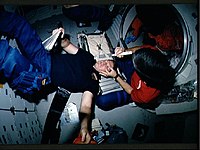
Photo from wikipedia
Spaceflight associated neuro-ocular syndrome (SANS) is unique to long duration space flight and has no direct terrestrial equivalent. Sater et al. describe novel automated magnetic resonance imaging (MRI) techniques for… Click to show full abstract
Spaceflight associated neuro-ocular syndrome (SANS) is unique to long duration space flight and has no direct terrestrial equivalent. Sater et al. describe novel automated magnetic resonance imaging (MRI) techniques for the quantification of one of the key structural changes seen in SANS, namely posterior globe flattening. In addition, the authors use the same techniques to study the recovery and change in globe flattening after return from long-duration space flight (LDSF). Cephalad fluid shifts that occur with the loss of hydrostatic pressure gradients in a microgravity environment during LDSF is one of the predominant proposed mechanisms for SANS. These orbital fluid shifts in the choroidal and orbital vascular and cerebrospinal fluid compartments are believed to alter the mechanical forces at the posterior globe leading to flattening and secondary hyperopic refractive shifts during and after LDSF. In this fascinating study [1–4], Sater et al. quantified volumetric displacement of the posterior globe in ten astronauts at 5 timepoints after LDSF (~6-months duration). The mean globe volumetric displacement was 9.88 mm on the first day of assessment after the return (R+) from mission; 9.00 mm at R+ 30 days; 6.53 mm at R+ 90 days; 4.45 mm at R+ 180 days; and 7.21 mm at R+ 360 days. The authors concluded that there was a consistent inward displacement of the globe at the optic nerve, which had only partially resolved 1 year after landing. These findings suggest significant measurable but also reversible structural changes in SANS on MRI. Although the focus of this article was on quantitative MRI assessment of the posterior globe flattening, there are other neuro-ocular changes observed in SANS include choroidal folds, optic disc edema, and hyperopic shifts. Orbital ultrasound and optical coherence tomography (OCT) have been performed before, during, and after LDSF and have demonstrated the structural changes associated with SANS clinically. Although prior multimodal imaging techniques have been performed (e.g., OCT) in astronauts with globe flattening this is the first prospective quantitative analysis of spaceflight-induced globe flattening using MRI. One leading hypothesis for the pathogenesis of SANS is that globe flattening results from sustained cephalad fluid shift during LDSF and exposure to microgravity. This work helps to document the severity but also the reversibility over time of the structural changes in the posterior globe after return to Earth and a one G environment. I commend the authors for their excellent work and future research will be necessary to determine the underlying cause(s) of SANS as well as test any hypothesis for potential countermeasures as NASA and its partners across the globe prepare for even longer duration space flights including a possible manned mission to Mars.
Journal Title: Eye
Year Published: 2021
Link to full text (if available)
Share on Social Media: Sign Up to like & get
recommendations!